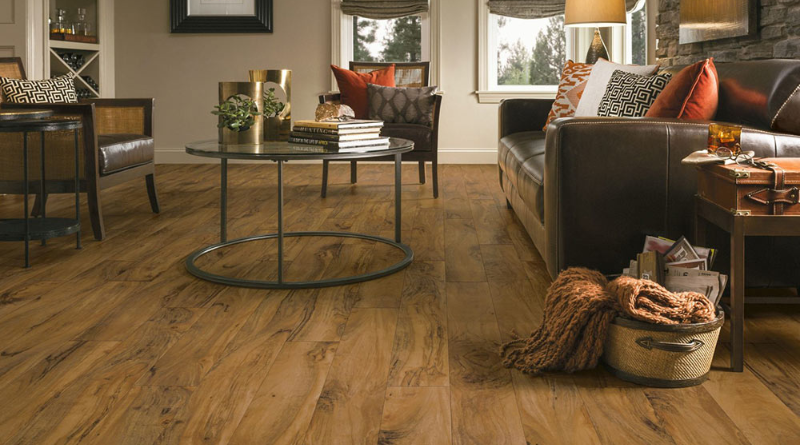Hardwood floors are a beautiful, long-lasting feature in any home, but over time they can lose their luster. Scratches, dents, and dullness are common issues as floors endure years of foot traffic, spills, and moving furniture. If your floors are looking a bit worn, refinishing hardwood floors or resurfacing may be the solutions you need to bring them back to life. But what’s the difference between these two options, and which is the right choice for your floors?
What is Resurfacing?
Resurfacing is a less invasive way to restore your hardwood floors. The process focuses on the top layer of the wood, removing minor surface scratches and imperfections. A fresh layer of finish or stain is applied, giving your floors a polished look.
Resurfacing is an ideal choice if your floors are still in generally good condition, with only light wear. This process doesn’t address deeper scratches, dents, or damage from water, so it’s best suited for floors that need a light touch-up rather than major restoration.
Steps in the Resurfacing Process:
- Preparation: The area is cleared of furniture, rugs, and any items on the floor. The floor is thoroughly cleaned to remove dust and dirt.
- Light Sanding: The floor is lightly sanded to smooth out minor scratches and scuffs, helping the new finish adhere better.
- Applying Finish: A new layer of finish or stain is applied to restore the shine. You can match the original color or choose a different stain for a slight update.
- Drying and Curing: The finish needs time to dry and cure, usually over several days, to ensure a long-lasting result.
Resurfacing can be a quick, cost-effective way to enhance the look of your floors without the need for heavy-duty equipment or lengthy drying times. However, it’s important to note that resurfacing won’t cover deep scratches or fix significant damage; for that, refinishing may be necessary.
What is Refinishing?
Refinishing is a more thorough process designed for floors that have taken a beating. This involves sanding down the entire top layer of wood to remove deep scratches, dents, and other imperfections. Refinishing can even address issues like discoloration or water stains that are impossible to fix with resurfacing alone.
Refinishing is often the better option if your floors have major damage or if you want to completely transform the look, such as changing the floor’s color.
Steps in the Refinishing Process:
- Inspection and Cleaning: Floors are inspected for damage, and any dirt, dust, or debris is removed.
- Sanding: A powerful sander removes the entire top layer, exposing the raw wood. This process smooths out deep scratches and dents, preparing the wood for a fresh finish.
- Staining (Optional): If you’d like a new color, a stain is applied to change the floor’s appearance.
- Sealing: A protective sealant is added to preserve the wood and keep it looking polished.
- Buffing and Final Touches: The floor is buffed for smoothness, and any final details, like trim or molding, are addressed.
Refinishing takes more time and skill but offers a like-new appearance that’s incredibly durable. By sanding down to the bare wood, refinishing removes all signs of damage and allows for a wide variety of finishes.
How Do They Compare?
Let’s break down some key differences:
1. Level of Repair:
- Resurfacing is suited for minor imperfections, while refinishing is ideal for deeper damage.
2. Cost:
- Resurfacing is more budget-friendly due to the lighter work involved.
- Refinishing is a larger investment but delivers a more dramatic transformation.
3. Durability:
- Refinishing offers a long-lasting finish that can handle more wear.
- Resurfacing is effective for light use and may need to be done more often in high-traffic areas.
4. Appearance and Customization:
- Resurfacing maintains the current color and hides light scratches.
- Refinishing allows for a completely new look, as you can change the color and finish.
5. Time Commitment:
- Resurfacing usually takes a few days and is less disruptive.
- Refinishing can take a week or more, as it involves multiple steps and longer drying times.
Which is Right for Your Floors?
Choosing between resurfacing and refinishing depends on your floor’s condition, your budget, and your goals. If your hardwood floors have only mild wear, resurfacing can be a quick and affordable option to restore their shine. However, if you’re dealing with deep scratches, discoloration, or water damage, refinishing will deliver a more thorough and longer-lasting result.
Consider factors like:
- Floor Condition: Inspect your floors to see if they have surface-level wear or deeper damage.
- Budget: Determine how much you’re willing to spend, as resurfacing is less costly, while refinishing may offer better long-term value.
- Time and Disruption: If you need the job done quickly, resurfacing may be best. For a full makeover, refinishing is worth the extra time.
Both resurfacing and refinishing can breathe new life into your hardwood floors, protecting them for years to come. Regular maintenance, like sweeping and using floor protectors, will also help keep your floors in good shape longer. With the right choice, you can enjoy beautiful, durable hardwood floors that enhance your home’s appeal.
